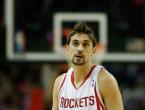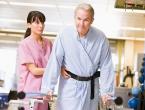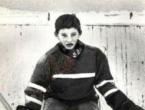Lecture on physical therapy for digestive diseases. Exercise therapy for diseases of the digestive system
Diseases of the digestive system occupy a significant place in clinical medicine. Diseases of the digestive system often affect people of the most working age, causing a high rate of temporary disability and disability.
In diseases of the digestive system, changes in motor, secretory and absorption functions are observed. Pathological processes of the gastrointestinal tract are in close relationship with each other and are caused by a violation of nervous regulation.
As a result of a violation of secretory function, gastritis, gastric and duodenal ulcers, etc. develop, and in case of motor function disorder, colitis, constipation, etc.
The main means of treating diseases of the digestive system are diet therapy, medications, massage, movements (physical therapy, moderate physical activity, etc.), physical and hydrotherapy procedures. Exercise therapy for this pathology has a general tonic effect, adjusts neurohumoral regulation, stimulates blood and lymph circulation in the abdominal organs, strengthens the abdominal muscles, helps normalize the evacuation and motor functions of the intestines, etc.
The result of the effects of physical exercise depends on its type, dosage, rhythm and tempo of implementation, on the stage of its application, the duration of the course, as well as on its combination with diet and other therapeutic agents.
Studies have shown that moderate physical exercise normalizes the secretory and evacuation functions of the stomach, while intense physical training, on the contrary, depresses it. The use of special exercises and segmental reflex massage helps to normalize impaired functions. Thus, exercises for the muscles of the abdominal wall and pelvic floor help well with chronic colitis, cholecystitis, dyskinesias, etc., and breathing exercises have a “massaging” effect on the internal organs, improving blood and lymph circulation in the abdominal cavity. At the same time, abdominal exercises, as studies have shown, sharply increase intra-abdominal pressure, so they are contraindicated in patients with exacerbation of gastric and duodenal ulcers, and spastic colitis. Such patients benefit from breathing exercises, relaxation exercises lying on the back with legs bent at the knees and hips, or in the knee-elbow position.
Massage facilitates the secretion of bile by increasing blood and lymph circulation in the liver and abdominal organs. Physical exercises help normalize impaired functions in dyskinesia of the gastrointestinal tract and biliary tract.
Thus, exercise therapy and massage have a positive effect on the abdominal organs and stimulate the regulatory mechanisms of the digestive system.
Gastritis is an inflammation of the gastric mucosa, which can be acute or chronic. Acute gastritis is most often the result of taking substances that irritate the mucous membrane, most often alcohol, eating poor quality or unusual food, certain medications, foodborne illnesses, and acute poisoning. During mass examinations of the population of industrialized countries, approximately 50% of people, many of whom did not complain of changes in the stomach, show signs of gastritis (V.Kh. Vasilenko, A.P. Grebnev; K. Villako et al., etc. ).
It has also been established that oxygen starvation of the body, being an important pathogenetic factor, has a great influence on the course and outcome of many internal diseases. Another thing is known: the glands of the gastric mucosa are very sensitive to oxygen deficiency. Prolonged hypoxia leads to atrophy of the gastric mucosa with the development of enzymatic and secretory insufficiency. Hypoxia of the gastric mucosa is aggravated by blood redistribution during heavy physical activity. The main portion of blood is sent to vital organs (brain, heart, liver, as well as to muscles), while the exchange blood flow in the abdominal organs is reduced.
Thus, hypoxia is the cause of chronic atrophic gastritis. Chronic gastritis - inflammatory change in the gastric mucosa of an endogenous or exogenous nature.
Characteristic signs of chronic gastritis are: unpleasant taste in the mouth, sour belching, nausea, especially in the morning, heaviness in the epigastrium, flatulence and pain resembling ulcers; with gastritis with secretory insufficiency, diarrhea is possible.
A major role in the occurrence of chronic gastritis is played by alcohol abuse, smoking, drugs, poor nutrition (chronic lack of animal proteins in food, vitamins B, A, C, E) and irregularity (dietary disorder) of food intake. Chronic gastritis is often caused by intense physical activity, including sports.
Gastritis is divided (taking into account the secretory function of the stomach) into gastritis with secretory insufficiency; gastritis with increased secretion and acidity; gastritis with normal secretory function. Athletes often experience gastritis with increased secretion and acidity, which often develops into peptic ulcer disease.
Most often, chronic gastritis with high acidity occurs in men. Symptoms: heartburn, sour belching, burning sensation, pressure and heaviness in the epigastric region. When palpating the abdomen, moderate pain is noted; Sometimes a neurasthenic syndrome is observed (increased irritability, poor sleep, fatigue, etc.)
Diet therapy, drug therapy, vitamins and other means are used for treatment. Exercise therapy, walking, skiing, swimming, and cycling are recommended. During sanatorium-resort treatment: swimming, walking and running along the seashore, playing on the seashore, diet, taking an oxygen cocktail, exercise therapy, etc.
LH includes general developmental and breathing exercises, relaxation exercises. For pain symptoms, cryomassage of the abdominal wall is indicated. However, exercises for the abdominal muscles are contraindicated. Walking, contrast showers, lying down exercises (breathing exercises, exercises for the distal parts of the lower extremities) are useful.
Objectives of massage: to provide an analgesic effect; normalize the secretory and motor functions of the stomach; activate blood and lymph circulation; eliminate the usually existing venous congestion; stimulate intestinal function.
Massage technique. Abdominal massage is performed with maximum relaxation of the abdominal wall muscles. Planar stroking, rubbing, kneading the muscles of the abdominal wall, oblique abdominal muscles, and vibration are used. Then, along the course of the large intestine (starting from its ascending part), stroking is carried out with the fingertips of the right hand. Stroking techniques are repeated 4-6 times, after which several superficial circular strokes are made to give the abdominal wall a rest, and then tapping with the fingertips along the intestine and shaking it is carried out to influence its wall. Finish the massage of the abdominal wall with planar stroking and diaphragmatic breathing. Duration of massage is 10-15 minutes.
Biliary dyskinesia.
Biliary dyskinesias are characterized by a disorder of the motor function of individual parts of the biliary system, including the sphincter of Oddi. This is facilitated by various autonomic nervous disorders. Biliary dyskinesia is the initial stage in the pathogenesis of other diseases of the biliary tract, contributing to the formation of gallstones and the development of infection. It is often combined with other functional disorders - duodenal dyskinesia, changes in the function of the stomach, intestines, and pancreas.
With a spastic, or hyperkinetic, gallbladder, short-term pain is noted in the right hypochondrium and epigastric region.
An atonic, or hypokinetic, gallbladder is characterized by dull, prolonged pain after eating, which intensifies when the patient sits for a long time. Evacuation of bile is slowed down.
Dyskinesias are quite common in athletes (cyclists, cross-country skiers, distance runners, etc.).
For the hyperkinetic form of dyskinesia characterized by paroxysmal pain (biliary colic), which occurs after physical exertion (overload) and is often accompanied by nausea, vomiting, bowel dysfunction, as well as irritability, headache, and deterioration of general condition.
Hypokinetic dyskinesia manifested by periodically occurring pain and a feeling of fullness in the right hypochondrium, sometimes by dyspeptic symptoms and deterioration of the general condition.
Complex treatment includes massage, physical therapy, diet therapy, drinking mineral waters, physiotherapy and hydrotherapy, drug therapy, herbal medicine and other remedies.
LH consists of general developmental and breathing exercises; The choice of starting position is of great importance. The best conditions for blood circulation in the liver, formation and secretion of bile are created in a lying position. To enhance the influence of the diaphragm, you can use breathing exercises while lying on your right side, since this increases the excursion of its right dome. In addition, LH is also performed while standing on the knees, as well as knee-elbow, which help relax the abdominal press and unload the spine, allowing you to perform exercises with raising and adducting the legs without sudden changes in intra-abdominal pressure.
In the hypokinetic form of dyskinesia, PH is performed lying on the back, on the left and right side, kneeling, kneeling with hands resting on the floor, sitting and standing. Perform general developmental and breathing exercises with gradually increasing amplitude and tempo of movements. The LH complex also includes abdominal exercises, walking; “belly breathing” helps reduce (or eliminate) pain. Duration of classes is 20-30 minutes. During the period of complete remission, games, skiing, rowing, skating, cycling, swimming, etc. are recommended.
In the hyperkinetic form of dyskinesia, PH is performed lying on the back, right and left side. Includes general developmental, breathing and relaxation exercises. Abdominal exercises, exercises with equipment (dumbbells, medicine balls), as well as straining and holding your breath are not recommended. The pace of the exercises is slow and medium. Duration of classes is 15-20 minutes. During the period of complete remission - dosed walking, skiing, swimming, occupational therapy, ice skating, etc.
Objectives of massage: normalization of the psycho-emotional state and function of the biliary tract, analgesic effect, elimination of congestion in the gallbladder.
Massage technique. First, massage is performed on the collar area and back (segmental zones VIII-X thoracic and I-II lumbar vertebrae, especially on the right) using segmental techniques. The massage is performed in a sitting position. Then, while lying on your back, massage your stomach and oblique abdominal muscles. The procedure is completed by squeezing the lower segments of the lungs (as the patient exhales). Repeat 3-5 times, then ask the patient to “breathe with his stomach” for 1-2 minutes (legs bent at the knees and hip joints). The following techniques are excluded: chopping, tapping and deep kneading (especially in the area of the right hypochondrium). The duration of the procedure is 8-12 minutes. A course of 10-15 procedures.
Digestive system diseases are divided into functional and organic. The infection most often affects the intestines, liver, and bile ducts, but can also cause stomach diseases (phlegmonous gastritis).
The effect of physical exercise on the digestive organs
The beneficial effects of physical exercise on the functions of the digestive organs have been known to people for a long time. However, only at the end of the 19th century, with the advent and improvement of methods for objective research of the digestive organs, the possibility of scientific study of the influence of muscular work on the activity of the digestive system opened up.
Exercise therapy for diseases of the digestive system, it is designed to solve the following problems:
general strengthening and healing of the patient’s body;
impact on the neuropsychic sphere and neurohumoral regulation of the digestive organs;
improvement of blood and lymph circulation in the abdominal cavity;
improvement of the trophic function of the central nervous system;
development, full breathing functions;
strengthening the muscular system and, in particular, the muscles of the abdominals, back, and pelvis.
Healing Fitness indicated for patients in the phase of fading exacerbation, as well as in the phase of incomplete and complete remission. During the period of exacerbation and during complicated course of the disease; digestive organs, physical therapy exercises should be stopped.
Classes are conducted in the form of morning hygienic exercises, therapeutic exercises(individual or small group), dosed walking; the best results are achieved by combining these forms with elements of hydrotherapy (partial wet rubbing, hygienic shower, etc.) and massage.
Therapeutic exercise for diseases of the digestive system
Chronic cholecystitis
Chronic cholecystitis is based on dyskinesia of the extrahepatic bile ducts, leading to stagnation of bile, which, in turn, can cause inflammation of the gallbladder - cholecystitis.
The chronic course of the disease is characterized by pain in the gallbladder and dyspeptic symptoms. Stagnation of bile is promoted by a sedentary lifestyle, general muscle weakness, especially weakness of the abdominal muscles, poor diet, etc.
Physiotherapy exercises are used in the remission stage. At the beginning of classes, only therapeutic exercises are used, which are carried out in different individual entrepreneurs.
The best IPs for the outflow of bile are considered to be lying on your back, on your left side and on all fours. The lateral position ensures free movement of bile. In therapeutic exercises, general strengthening exercises of moderate intensity are used for all muscle groups. Group classes are conducted for 25–30 minutes.
Class density is 60–65%. To create a positive emotional background, exercises with apparatus, on apparatus and games are used. Muscle relaxation exercises are also used. Strength exercises that cause a sharp increase in intra-abdominal pressure and exercises associated with body shaking are contraindicated.
An approximate set of exercise therapy exercises for chronic cholecystitis and biliary dyskinesia
1. IP - lying on your back. Raise your right arm up and at the same time bend your left leg, sliding your foot along the surface - inhale. Return to IP - exhale.
2. IP - lying on your back. Hands on the belt. Raise your head and shoulders, look at your toes - exhale. Return to the starting position - inhale.
3. IP - lying on your back. Place your left hand on your chest, your right hand on your stomach. Exercise in diaphragmatic breathing (that is, breathing from the stomach). When you inhale, both arms rise up, following the movement of the chest and the front wall of the abdomen, and when you exhale, they go down.
4. IP - lying on your left side, raising your right arm and right leg, inhale, bending your leg and arm, pull your knee to your stomach, tilt your head - exhale.
5. IP - lying on your left side, move your right arm straight up and back - inhale, return to the starting position - exhale.
6. IP - lying on your left side, take both legs back - inhale, return to the starting position - exhale.
7. IP - standing on all fours. Raising your head, inhale, move your right leg forward between your hands with a sliding movement - exhale. Return to the starting position and perform the same exercise with the other leg.
8. Standing on all fours, raise your left straight arm to the side and up - inhale, return to IP - exhale.
9. Standing on all fours, inhale, bending your arms, lie on your stomach - exhale, return to IP.
10. Standing on all fours, bend in the lumbar region - inhale, lower your head and arch your back - exhale.
Breathing exercises
Breathing exercises are accompanied by a significant change in intra-abdominal pressure, so they can only be performed at the recovery stage, making sure that no pain occurs.
1. IP - standing, hands on hips. Take a slow, moderately deep breath, draw in your stomach, and exhale sharply and strongly.
2. IP - the same. Exhale sharply and forcefully, draw in your stomach as much as possible and hold your breath for 6–8 seconds. Freely relax your abdominal muscles.
3. IP - sitting on the floor with legs crossed. The back is straight, hands on the knees. The head is lowered, the eyes are closed. The muscles of the face, neck, shoulders, arms, legs are completely relaxed. Take a slow, moderate-depth breath and hold your breath again for 1-2 seconds.
4. IP - standing. Inhale slowly for 1–2 s, hold your breath for 2 s. Repeat several times.
This text is an introductory fragment. From the book Polyclinic Pediatrics: lecture notes author Notes, cheat sheets, textbooks "EXMO" author Irina Nikolaevna Makarova From the book Massage and Physical Therapy author Irina Nikolaevna Makarova From the book Massage and Physical Therapy author Irina Nikolaevna Makarova From the book Massage and Physical Therapy author Irina Nikolaevna Makarova From the book Complete Medical Diagnostics Guide by P. Vyatkin From the book Treatment of Kidney Diseases author Elena Alekseevna Romanova From the book Treatment with milk and dairy products author Yulia Savelyeva From the book Physical Therapy author Nikolay Balashov author Mikhail Meerovich Gurvich From the book The Big Book of Nutrition for Health author Mikhail Meerovich Gurvich From the book The Big Book of Nutrition for Health author Mikhail Meerovich GurvichDiseases of the digestive system occupy a significant place in clinical medicine. Diseases of the digestive system often affect people of the most working age, causing a high rate of temporary disability and disability.
The location and general anatomy of the main parts of the digestive tract are shown in Fig. 83. The close anatomical and physiological connection between the digestive organs makes it impossible to separately treat one or another organ in case of its disease.
In diseases of the digestive system, changes in motor, secretory and absorption functions are observed. Pathological processes of the gastrointestinal tract are in close relationship with each other and are caused by a violation of nervous regulation.
As a result of a violation of secretory function, gastritis, gastric and duodenal ulcers, etc. develop, and in case of motor function disorder, colitis, constipation, etc.
The main means of treating diseases of the digestive system are diet therapy, medications, massage, movements (physical therapy, moderate physical activity, etc.), physical and hydrotherapy procedures. Exercise therapy for this pathology has a general tonic effect, adjusts neurohumoral regulation, stimulates blood and lymph circulation in the abdominal organs, strengthens the abdominal muscles, helps normalize the evacuation and motor functions of the intestines, etc.
The result of the effects of physical exercise depends on its type, dosage, rhythm and tempo of implementation, on the stage of its application, the duration of the course, as well as on its combination with diet and other therapeutic agents.
Studies have shown that moderate physical exercise normalizes the secretory and evacuation functions of the stomach, while intense physical training, on the contrary, depresses it. The use of special exercises and segmental reflex massage helps to normalize impaired functions. Thus, exercises for the muscles of the abdominal wall and pelvic floor help well with chronic colitis, cholecystitis, dyskinesias, etc., and breathing exercises have a “massaging” effect on the internal organs, improving blood and lymph circulation in the abdominal cavity. At the same time, abdominal exercises, as studies have shown, sharply increase intra-abdominal pressure, so they are contraindicated in patients with exacerbation of gastric and duodenal ulcers, and spastic colitis. Such patients benefit from breathing exercises, relaxation exercises lying on the back with legs bent at the knees and hips, or in the knee-elbow position.
Rice. 83. Organs of the thoracic and abdominal cavities: 1 - larynx; 2 -
windpipe; 3 - upper lobe of the left lung; 4 - pulmonary trunk; 5 - heart; b- diaphragm; 7 - stomach; 8 - spleen; 9 - transverse colon; 10 - small intestine; 11 - sigmoid colon; 12 - bladder; 13 - cecum; 14 - ascending colon; 15 - gallbladder; 16 - liver; 17 - upper lobe of the right lung; 18 - aorta; 19 - brachiocephalic vein; 20 - left subclavian vein; 21 - left internal jugular vein; 22 - right common carotid artery
Massage facilitates the secretion of bile (V.I. Dubrovsky, 1973, 1985) by increasing blood and lymph circulation in the liver and abdominal organs. Physical exercises help normalize impaired functions in dyskinesia of the gastrointestinal tract and biliary tract.
Thus, exercise therapy and massage have a positive effect on the abdominal organs and stimulate the regulatory mechanisms of the digestive system.
Diseases of the digestive system occupy a significant place in clinical medicine. Diseases of the digestive system often affect people of the most working age, causing a high rate of temporary disability and disability.
The location and general anatomy of the main parts of the digestive tract are shown in Fig. 181. The close anatomical and physiological connection between the digestive organs makes it impossible to separately treat one or another organ in case of its disease.
In diseases of the digestive system, changes in motor, secretory and absorption functions are observed. Pathological processes of the gastrointestinal tract are in close relationship with each other and are caused by a violation of nervous regulation.
As a result of a violation of secretory function, gastritis, gastric and duodenal ulcers, etc. develop, and in case of motor function disorder, colitis, constipation, etc.
The main means of treating diseases of the digestive system are diet therapy, medications, massage, movements (physical therapy, moderate physical activity, etc.), physical and hydrotherapy procedures. Exercise therapy for this pathology has a general tonic effect, adjusts neurohumoral regulation, stimulates blood and lymph circulation in the abdominal organs, strengthens the abdominal muscles, helps normalize the evacuation and motor functions of the intestines, etc.
The result of the effects of physical exercise depends on its type, dosage, rhythm and tempo of implementation, on the stage of its application, the duration of the course, as well as on its combination with diet and other therapeutic agents.
Studies have shown that moderate physical exercise normalizes the secretory and evacuation functions of the stomach, while intense physical training, on the contrary, inhibits it. The use of special exercises and segmental reflex massage helps to normalize impaired functions. Thus, exercises for the muscles of the abdominal wall and pelvic floor help well with chronic colitis, cholecystitis, dyskinesias, etc., and breathing exercises have a “massaging” effect on the internal organs, improving blood and lymph circulation in the abdominal cavity. At the same time, abdominal exercises, as studies have shown, sharply increase intra-abdominal pressure, so they are contraindicated in patients with exacerbation of gastric and duodenal ulcers, and spastic colitis. Such patients benefit from breathing exercises, relaxation exercises lying on the back with legs bent at the knees and hips, or in the knee-elbow position.
Massage facilitates the secretion of bile (V.I. Dubrovsky, 1973, 1985) by increasing blood and lymph circulation in the liver and abdominal organs. Physical exercises help normalize impaired functions in dyskinesia of the gastrointestinal tract and biliary tract.
Thus, exercise therapy and massage have a positive effect on the abdominal organs and stimulate the regulatory mechanisms of the digestive system.
| | | next lecture ==> | |




